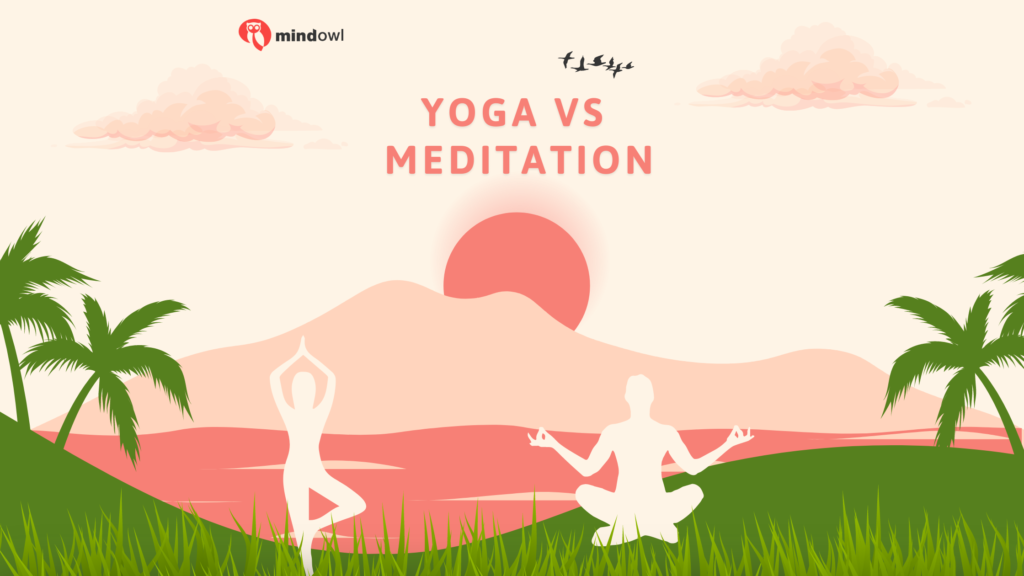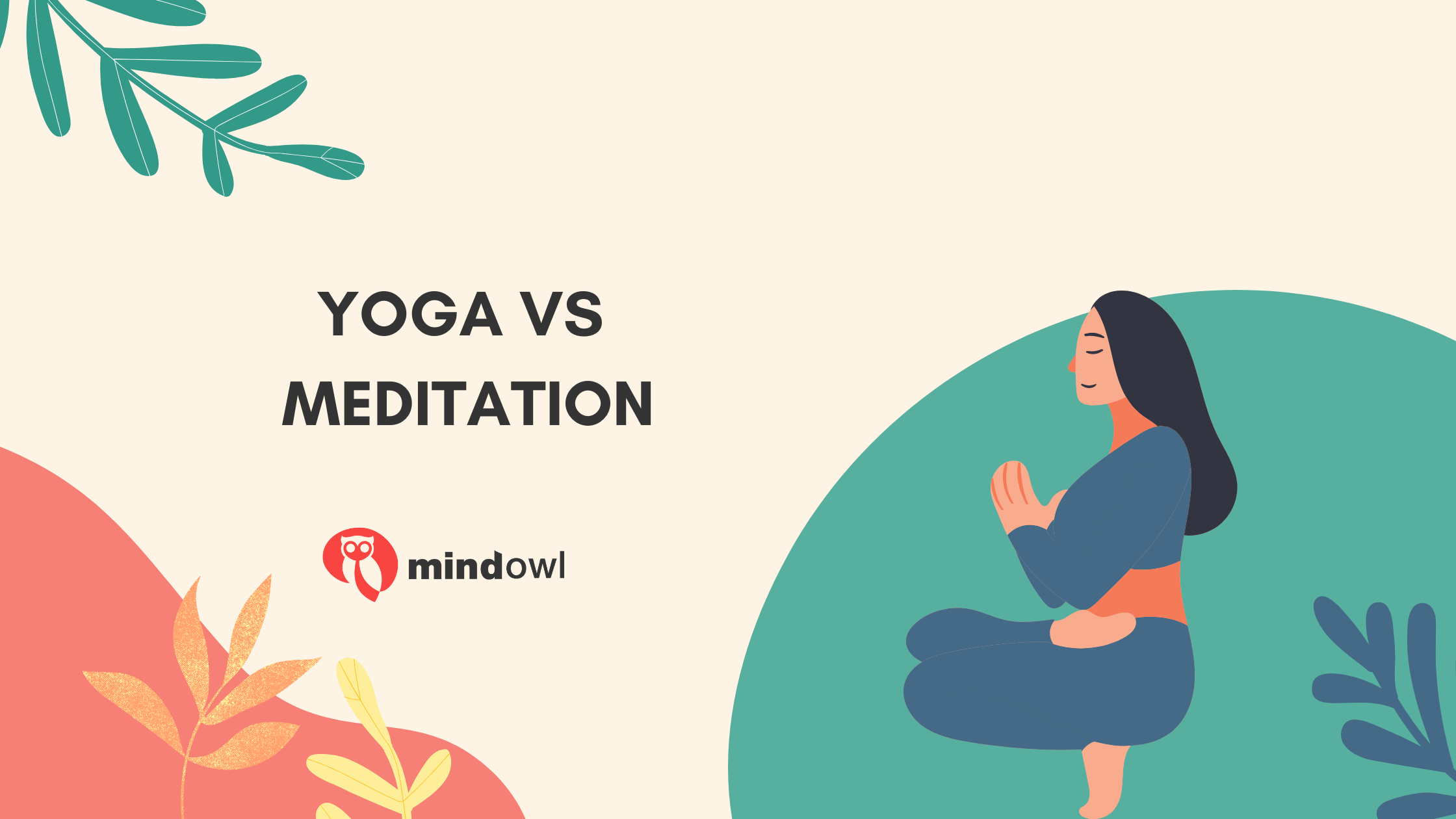Yoga vs Meditation: differences and similarities and which is better for you? Some people might tell you that Yoga and meditation are the same things, although that’s not actually true.
There are many differences between these two practices, ranging from the goals and motivations behind them to the effects and benefits they produce. Yoga (as it’s practised in Western countries) is usually a form of exercise, and its calming effects are often a secondary benefit (similar to many other types of exercise). When we meditate, however, our main goal is to gain a deeper understanding of our true self, break down the habits of self-doubt and reduce the impact of negative emotions. Meditation is a very powerful tool to help us become more aware of ourselves. It helps us understand who we really are, what makes us happy, and what keeps us stuck.
In this article, we will take you through the similarities and differences between yoga and meditation. We’ll explain how to use both practices, and we’ll explore the positive effects of them both. Later on, we’ll also look into how and why yoga can’t replace meditation in your daily mindfulness practice.

What Is Yoga?
Yoga is a collection of practices that originated in Ancient India as far back as 2700 BC, developed to improve physical and mental well-being and health. In Sanskrit, “yoga” translates as “the union of your soul” and “the divine spirit”. In the modern world, we can understand Yoga as a form of exercise that builds your core strength, flexibility, and breath in order to improve not only your physical well-being but also your mental health.
During Yoga, participants practice physically demanding or “activating” poses, combined with controlled, sustained breathing. This activates and stimulates the sympathetic nervous system, which triggers our “fight or flight” response. Then, when a soothing pose is adopted, the parasympathetic nervous system is triggered, placing you, your body, and your mind into a calm and restorative state.
Mindfulness Yoga has a wide variety of health benefits; it increases your energy, lowers blood pressure, keeps you strong and flexible, and soothes the symptoms of anxiety disorders and depression. These effects of yoga will all, in turn, help you sleep much better. Many people welcome Yoga as a lifestyle and use it as a holistic approach to focus their mind and body. But, without bringing meditation into play and combining it with yoga, you may not gain the full advantages of the practice. Breath coordination with Yoga postures without intentional mindfulness practice may be helpful for making you fitter, but what about your mind? Later, we’ll explore this idea in more detail.
There are a huge variety of different approaches to yoga practice, but all of them are linked by their ability to positively alter your life. Let’s take a look at a few of them.
What different types of yoga practice are there?
Traditionally, the practice of Yoga is divided into three main strands; “Asanas” or postures, “Pranayama” or breathwork, and “Dhyana” or meditation. These separate aspects of yoga come together to create a physical practice that gets us in tune with the inner workings of the mind and increases our focus and awareness.
Those that are following a more spiritual path with Yoga may use the form Chakra Yoga, which is different from classical Yoga. Chakra Yoga combines the practices of other yoga traditions and seeks to “activate” the chakra energies along the spine. Antaranga Yoga is the practice of seeking your inner path. “Antaranga” in Sanksrit means “internal,” “inner” or “inside.” It is also associated with Ashtanga yoga and when combined they are referred to collectively as Antaranga Sadhana which means spiritual practice or discipline.
Iyengar Yoga is a form of practice created by Indian yoga teacher and author Bellur Krishnamachar Sundararaja Iyengar. In this form of yoga, there is a focus and emphasis on the structural integrity of the yoga poses you are doing, with practitioners focusing on asana practice. Another structurally focused yoga practice is Vinyasa Yoga or “flow” Yoga, which is the practice of performing yoga postures seamlessly without a break by following the flow of your breath.
Yoga enthusiasts usually uplevel their skills by enlisting for Bali yoga teacher training certification courses and the like. Such programs can provide you with the knowledge, skills, and experience you need to become an effective yoga teacher.
A yoga teacher training program can deepen your own yoga practice and learn more about the philosophy and history of yoga. It can also be a life-changing experience that helps you connect with your inner peace and find your true purpose in life.
In addition, certification can open up new career opportunities, such as teaching yoga classes at studios, gyms, or resorts. You may also be able to use your certification to get a job as a yoga instructor at a health club or fitness center.

What Is Meditation?
Meditation is about becoming aware of yourself and your mind, in the present moment, without judgement. It is a way to connect with your thoughts, feelings, and sensations without being controlled by them. The word comes from the Latin “meditatio” meaning “to think deeply”. By training your awareness, meditation helps you gain more control over your deepest thoughts and detach from your reactive self. It is also a practice that helps train our minds and build the muscle of mindfulness, to come closer to our essential, true self and nature. All religions include some form of meditation, like walking contemplation or a simple prayer.
Although meditation can be used within various faiths, today most people meditate secularly. Many psychologists and psychotherapists have integrated meditation techniques into their training courses or therapeutic exercises, as a way of boosting psychological well-being. There are many different forms of meditation, varying from concentrative practices and mindfulness meditation, to mindfulness-based stress reduction (MBSR) and mindfulness-based cognitive therapy (MBCT). Broadly speaking, each practice will fit into one of six main styles of meditation.
Like Yoga, meditation has many psychological and physical health benefits. According to studies, these include reduced blood pressure and heart rate throughout the day, lowered stress and enhanced stress management skills, as well as a positive difference in symptoms of psychiatric disorders like chronic depression or major depression and anxiety disorders.
People who want to master the art of meditation take teacher training programs. These typically cover various topics, including history, different types, benefits of meditation, and the principles of effective teaching.
In addition, meditation teacher training programs can be either online or in-person. Online programs are typically less expensive than in-person programs but may not offer the same level of interaction with instructors and other students. The latter typically offers more hands-on learning and personal development opportunities but can be more expensive and time-consuming.
What Is the Difference between Yoga and Meditation?
While meditation is considered a part of yoga, when people talk about meditation and yoga they are talking about two very different practices. It is important to remember the differences — below are some of the key ones.
1) Yoga is a physically active practice, while Meditation is an internal process. When you are a regular meditation practitioner, you can incorporate physical practices like yoga into your daily life to contribute to a happy and balanced lifestyle; however, when starting out, meditation requires lots of concentration and is much more mental than it is physical.
2) Yoga does not train the mind, and meditation does not necessarily train the body. Instead, it’s a process of cultivating certain states of mind. Mediating is about training yourself to stay focused and not be distracted by unwanted thoughts and emotions, while yoga focuses on poses and breathing exercises.
3) Yoga can be particularly strenuous and physically demanding, especially as the poses get more intricate. Although the physical movement of yoga, the “asana,” promotes mindfulness as you connect with the present moment through the movements you are doing, those with chronic disease induced pain are often unable to experience this moment because they are experiencing too much pain. In contrast, mindfulness meditation can be used to relieve chronic pain.
What Do Meditation and Yoga Have in Common?
Although there is a difference between meditation and yoga, there are lots of things they have in common. Meditation and yoga are both beneficial for the overall health of the body and mind. Let’s consider some of the key positive effects that both these two practices can have.
1) One of the shared benefits of yoga and meditation is improved concentration. When we meditate, we’re able to focus on one thing at a time. We can’t stop thinking about other things and just listen to our own thoughts. By focusing on one thing at a time we can train ourselves and hone the skill of redirecting our attention and thoughts to better, more productive things. Yoga sessions use a similar process, albeit more tuned to the body than the mind.
2) Both Yoga and Meditation reduce stress levels. Meditation helps us to understand why we’re feeling stressed in the first place, and then redirect our thoughts and actions towards something positive. Yoga has many of the same benefits, helping us to manage psychological stress, enhance cardiovascular health and improve our quality of life.
3) Both Yoga and Meditation can help you become more mindful and intentional. When we meditate, we observe our thoughts and emotions without judging or reacting to them. This allows us to gain insight into what’s going on inside our minds and gain greater control over mental processes. Similarly, yoga encourages practitioners to think carefully about their physical actions, breathwork patterns, and mental states.
Clearly then, both meditation and yoga can help you clear your head and get rid of stress. So what happens if we combine the two practices?
Combining meditation and yoga can help you experience better sleep, improved peace of mind, better mental stability, and greater capacity for empathy towards yourself and others. Yoga and meditation go hand-in-hand with one another; you can do yoga postures while meditating, or meditate during one of your personal yoga classes online. Let’s explore how this will work in your daily life.
Combining Yoga and Meditation
Both yoga and meditation can have a powerful effect on your experiences of daily living. But combining them isn’t always easy — certain challenges can arise. Here are a few tips to make sure you don’t get caught up focusing too much on the physical aspect of yoga, and focus more on the mindful meditation aspect of the practice.
If you are going to combine your yoga and meditation practices, you should start by practising each separately before bringing them together. This way, you’ll understand the basics of both. Strong and reliable meditation practice will allow you to be more conscious and mindful of your movements and positions in yoga, which will enhance and deepen your yoga practice and make the benefits more pronounced.
By integrating yoga and mindfulness meditation techniques (a process sometimes called Mindful Yoga or Yoga Meditation), you have the opportunity to practise becoming more comfortable with uncomfortable emotional or physical health issues, leading to a better understanding of bodily sensations, thoughts, and feelings. This will help you get closer to your true nature and your essential, inner self – away from the influence of your thoughts and feelings.
There is no doubt that dedicated Mindfulness Yoga differs from other Yoga practices in that it emphasises mind-body awareness rather than exact alignment details and physical postures. A posture or “asana” is a Sanskrit term used in yoga that directly translates to “seat”. By cultivating mindfulness through asana, we become aware of our body and mind which gives us a heightened sense of self. Skills learned on the mat at a meditation retreat can then be transferred to everyday situations through the use of mindfulness techniques outside of yoga and meditation.
Why Meditation can’t be replaced with Yoga
As you can see, there are many great reasons why we here at MindOwl would encourage you to incorporate Mindful Yoga into your everyday meditation routine, separate from your daily meditation session.
Often, yoga asana exercises are done in preparation for the main meditation session. You can use activating, invigorating poses like sun salutations, cat-to-cow, and downward-facing-dog to help stimulate and engage your sympathetic nervous system. When you finish your meditation session, engage in some relaxing Yoga poses like forward bends or corpse poses to rouse your parasympathetic nervous system and trigger your body to go into a physical state of relaxation and calm. This can help you move through emotional and physical issues and tensions, preparing the body to sit in meditation, where you’ll incorporate mindfulness training, focus, awareness, and movement into your practice.
Try out a meditation app with guided physical exercise! Using restorative yoga flows (slow yoga practices that incorporates yin yoga poses) would be a great way to ease into your meditation practice. Yin yoga is a relaxing slow yoga practice that puts focus on holding asanas or postures for longer durations to develop your awareness and attention.
In this way, you will be able to use Yoga as a formative tool for your meditation sessions, ensuring that your awareness, focus, and intention are all engaged during meditation. You will be able to focus on the present moment, disregard the negative effects of thoughts and sensations to engage your true inner self.
End Goals
The positive effects of meditation are well-known; it can enable us to achieve stable states and a sense of calm both mentally and physically. Therefore, it can be useful to perform meditation after a yoga session, when your body and mind are in the present moment and unattached to negative emotions and thoughts. When you meditate after yoga, you are calm, relaxed, and your breath control is better. This allows your concentration to improve and your body to actively participate in the practice. Combining the two practices in this way can shine a light on the positive effects of yoga.
As we explored earlier, there are key differences between Yoga and Meditation. Meditation, for example, can be done on the move, although it’s more effective when practised within a designated meditation session. But there are similarities and common benefits too; these include reduced anxiety and stress, decreased pain, a greater sense of calm, and reduced symptoms of depression and other mental health conditions. The goal of meditation is to train your mind, while yoga focuses more on training the body — but there’s no need to choose one practice over the other.
We can enhance our mindfulness-based meditation practices by beginning and ending each meditative session with a sequence of activating and calming postures. Combining aspects of yoga with meditation can enhance the power of both techniques.
If you would like to find out more about mindfulness meditation, explore our online community of meditation courses, resources, and conversations. We cover a wide range of meditation techniques that are scientifically proven to improve quality of life and lead towards greater peace of mind. Check out our free taster course to find out what you’re missing.
Frequently Asked Questions
Which is better: yoga or meditation?
If you are looking for a way to reduce stress and anxiety, then both yoga and meditation can be beneficial. However, if you prefer movement and physical activity, then yoga may be a better option for you. If you are looking to understand and calm your mind, then meditation may be a better choice. Neither is inherently better than the other – it is simply a matter of what your goals and preferences are.
Are meditation and yoga the same thing?
A. No, meditation and yoga are not the same thing. Yoga is a form of exercise that uses specific body postures to achieve physical and mental health benefits, while meditation is a practice that can be done with or without movement in order to focus and calm the mind.
Is it better to do yoga or meditation first?
It depends on what you want to achieve. If you are looking to reduce your stress levels by engaging with your mindful self, then doing yoga before meditation would be beneficial. If you want to be in a meditative state for your exercise, then meditate first — prioritise engaging your mind before your body.
MindOwl Founder – My own struggles in life have led me to this path of understanding the human condition. I graduated with a bachelor’s degree in philosophy before completing a master’s degree in psychology at Regent’s University London. I then completed a postgraduate diploma in philosophical counselling before being trained in ACT (Acceptance and commitment therapy).
I’ve spent the last eight years studying the encounter of meditative practices with modern psychology.

